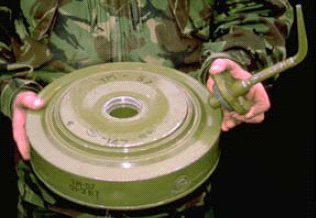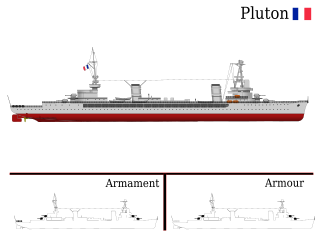
A narrow-gauge railway is a railway with a track gauge narrower than 1,435 mmstandard gauge. Most narrow-gauge railways are between 600 mm and 1,067 mm.

The Claymore mine is a directional anti-personnel mine developed for the United States Armed Forces. Its inventor, Norman MacLeod, named the mine after a large medieval Scottish sword. Unlike a conventional land mine, the Claymore may be command-detonated, and is directional, shooting a wide pattern of metal balls into a kill zone. The Claymore can also be activated by a booby-trap tripwire firing system for use in area denial operations.

The Heinkel He 115 was a three-seat World War II Luftwaffe seaplane. It was used as a torpedo bomber and performed general seaplane duties, such as reconnaissance and minelaying. The aircraft was powered by two 960 PS BMW 132K nine-cylinder air-cooled radial engines. Some later models could seat four, had different engines or used different weapon arrangements.

The Martin P6M SeaMaster was an experimental strategic bomber flying boat built by the Glenn L. Martin Company for the United States Navy that almost entered service; production aircraft were built and Navy crews were undergoing operational training, with service entry expected in about six months, when the program was cancelled on 21 August 1959. Envisioned as a strategic nuclear weapon delivery system for the Navy, the SeaMaster was eclipsed by the Polaris submarine-launched ballistic missile (SLBM). Due to the political situation at the Pentagon, the Navy promoted the P6M primarily as a high speed minelayer.

The Tupolev Tu-14, was a Soviet twinjet light bomber derived from the Tupolev '73', the failed competitor to the Ilyushin Il-28 'Beagle'. It was used as a torpedo bomber by the mine-torpedo regiments of Soviet Naval Aviation between 1952–1959 and exported to the People's Republic of China.

The RAC 112 APILAS is a portable one-shot 112 mm recoilless anti-tank weapon, designed in France by GIAT Industries. Over 120,000 of the APILAS launchers have been produced, and they are in service with many countries.

The Unrotated Projectile (UP) was a British anti-aircraft and ground-bombardment rocket of the Second World War. A 7-inch version was developed for the Royal Navy by Alwyn Crow of the Projectile Development Establishment of the Ministry of Supply at Fort Halstead. It proved unreliable and ineffective and was withdrawn from use in 1941. Development of the concept led to the UP-2 and UP-3, which had diameters of 2-inch and 3-inch respectively but were longer. The latter was used as the basis of the Z Battery anti-aircraft weapons and later developed in air-to-ground form as the RP-3, used against ground forces and shipping by aircraft like the Hawker Typhoon and the Bristol Beaufighter. In 1944–1945 several adaptations for general bombardment were produced, including Sea Mattress, Land Mattress, LILO and Tulip.

The National Engineering & Scientific Commission (NESCOM) is a Pakistani government-funded defense contractor that develops, designs and sells defense hardware, including missile and weapon systems. It was funded and formed by the Government of Pakistan to develop its domestic production of weapon system.

The Tellermine 42 (T.Mi.42) was a German metal-cased anti-tank blast mine used during the Second World War. The mine was a development of the Tellermine 35 with improved resistance to blast. It was followed by the simplified Tellermine 43. The Tellermine consists of a circular pressed steel main body with a large central pressure plate. The pressure plate is smaller than the earlier Tellermine 35, which increases the mine's resistance to blast. Two secondary fuze wells are provided for anti-handling devices, one in the side, and one on the bottom of the mine. The mine has a carrying handle.

The Bayan class was a group of four armored cruisers built for the Imperial Russian Navy around the beginning of the 20th century. Two of the ships were built in France, as Russian shipyards had no spare capacity. The lead ship, Bayan, was built several years earlier than the later three. The ship participated in several of the early naval battles of the Russo-Japanese War of 1904–05, and provided naval gunfire support for the Imperial Russian Army until she struck a mine. Bayan was trapped in harbor during the subsequent Siege of Port Arthur, and was sunk by Japanese artillery. She was salvaged and put into service with the Imperial Japanese Navy with the name of Aso. She mostly served as a training ship before she was converted into a minelayer in 1920. The ship was sunk as a target in 1932.

The TM-57 mine is a large, circular Soviet metal-cased blast anti-tank mine. It can either be triggered by a pressure or a tilt-rod fuze. A development of the TM-46 mine, it is found in Africa, the Middle East, and South East Asia.

The TM-46 mine is a large, circular, metal-cased Soviet anti-tank mine. It uses either a pressure or tilt-rod fuze, which is screwed into the top. Anti-tank mines with this type of fuze were capable of inflicting much more damage to armored vehicles, when compared to a typical anti-personnel mine.

The M19 is a large square plastic cased United States anti-tank blast mine. Intended to replace the M15 mine, the design dates from the mid-1960s and contains only two metal components: the copper detonator capsule and a stainless steel firing pin which weighs 2.86 grams. It is a minimum metal mine, which makes it very difficult to detect after it has been emplaced. This mine is produced under licence in Chile, South Korea and Turkey. A copy is produced in Iran. It is found in Afghanistan, Angola, Chad, Chile, Cyprus, Iran, Iraq, Jordan, South Korea, Lebanon, the Western Sahara, and Zambia.
The Expal C-3-A and C-3-B are round Spanish rubber modified polystyrene cased anti-tank blast mines. The mines differ only in minor detail. The mine is classified as a minimum metal mine, the only metal it contains being a 4.5 millimetre diameter zinc-plated steel spring. The mine is found in Angola, the Falkland Islands, and the Western Sahara. The mines are vulnerable to the plastic cases deteriorating in bright sunlight, resulting in a reduction in activation pressure.
The SB-81 is an Italian plastic cased minimum metal anti-tank blast mine dating from the early 1980s. The mine uses an air pressure based fuze, which gives it protection against overpressure and blast. It can therefore be regarded as a blast resistant mine. The mine can be scattered by hand or by mine laying systems.

The M1, M1A1 and M4 are circular steel cased United States anti-tank blast mines with a distinctive cross shaped pressure spider. The mine was used during the Second World War and a copy produced in Argentina was used during the Falklands War. Another copy is produced in China, there designated as the No. 4 mine. Variants of the mine have also been deployed in Chad and Tunisia.

The M21 is a circular United States anti-tank landmine that uses a Misznay Schardin effect warhead. The mine uses an M607 pressure fuse, which can be adapted as a tilt rod fuze. The mine is triggered either by pressure, or by the tilt rod being forced beyond 20 degrees from the vertical by a force of more than 1.7 kg, either of these actions results in pressure being transferred via a bearing cap to a Belleville spring, which inverts, driving the firing pin into the M46 detonator. The M46 charge first ignites a black powder charge, which blows off the mine's cover, and clears any earth or debris that may have been on top of the mine. A fraction of a second later the main warhead detonates, driving and compressing a steel plate upwards, with enough force to penetrate 76 mm of armour at a distance of 530 mm. Approximately 200,000 M21 mines were produced in the U.S. and licensed copies, the K441 and K442, were produced in South Korea.

Pluton was a fast minelaying cruiser built for the French Navy in the late 1920s. She was also able to carry 1,000 troops on her mine deck as a fast troop transport. Shortly after completion she was modified and became a gunnery training ship, replacing the elderly armored cruiser Gueydon. Shortly before the beginning of World War II, she reverted to her original role and most of the gunnery training equipment was removed. She was sent to Casablanca, in French Morocco, when the war began to lay a minefield, but the order was cancelled a day later and she was ordered to disembark her naval mines. She exploded while landing her still-fuzed mines on 13 September 1939.

The Hafthohlladung, also known as the "Panzerknacker", was a magnetically adhered, shaped charge anti-tank grenade used by German forces in World War II, and was sometimes described as a mine.
NATO AEP-55 STANAG 4569 is a NATO Standardization Agreement covering the standards for the "Protection Levels for Occupants of Logistic and Light Armored Vehicles".
















